
Research: Double Chooz
The Search for the Third Neutrino Mixing Angle
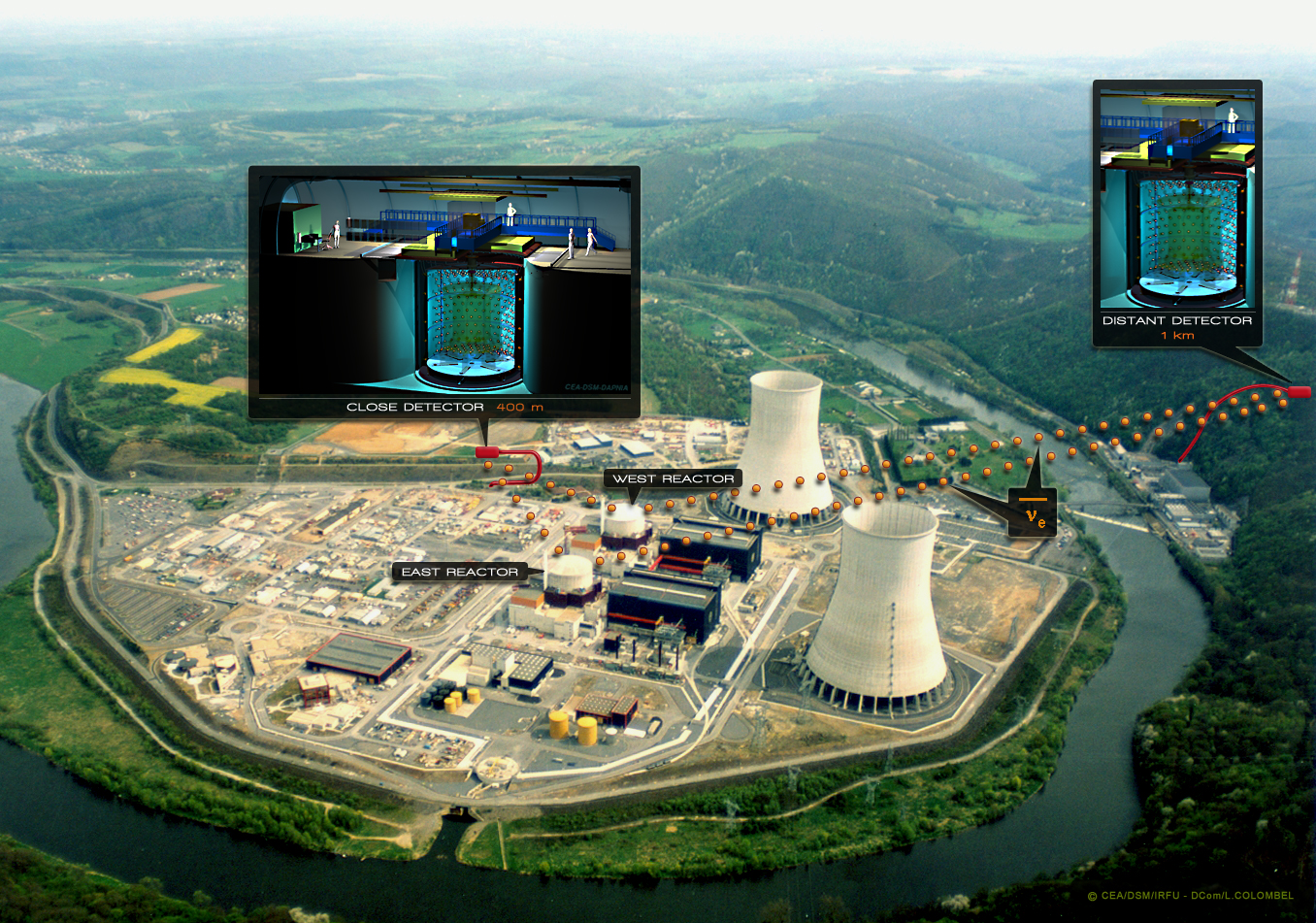
Figure 1: The positions of the two detectors at the power plant.
The Double-Chooz experiment is investigating the remarkable property of neutrinos to convert from one type
(flavour) into another. This process is called neutrino oscillations. The experiment is performed in the
framework of an international collaboration at the nuclear power reactors at Chooz in northern France.
At a nuclear power reactor a large number of about 1022 antineutrinos per GW thermal power are produced in nuclear processes. In order to
determine the conversion probability, two practically identical detectors are constructed at different
distances (0.4 km and 1.05 km) to the reactor. Neutrinos very rarely react with matter and their conversion
probability is low. Therefore, it takes several years of measurements to detect a sufficient number of
neutrinos to determine this probability with high accuracy.
Neutrinos
Neutrinos are elementary particles which occur as three different flavours: electron neutrino, muon neutrino
and tau neutrino. For each neutrino, there is also an antineutrino. Large experimental progress has been
achieved in recent years: It is known that neutrinos can convert from one flavour into another. To describe
the probabilities of these conversions, besides others, the so-called mixing angles (named θ12,
θ23, θ13) are required. Two of the three mixing angles (θ12,
θ23) were already determined experimentally in the past. The third angle (θ13)
is determined by the Double Chooz experiment. This angle parameterizes the admixture of the heaviest neutrino
mass eigenstate to the electron neutrino and leads to an energy and baseline dependent oscillation of the
electron anti-neutrino flux.
The smallness of θ13 in comparison with the large values of the other two mixing angles
θ12 and θ23 remains enigmatic. Measuring the unknown angle θ13
is crucial to understand the mass and mixing pattern of leptons. Therefore, the result of Double Chooz is an
important step towards a comprehensive understanding of neutrinos and the underlying theoretical models.
Double Chooz is also a key experiment for future experiments with neutrino beams searching for the leptonic
CP violation, as the sensitivity of those experiments strongly depend on the value of sin2 (2θ13).
Concept of the Double-Chooz Experiment
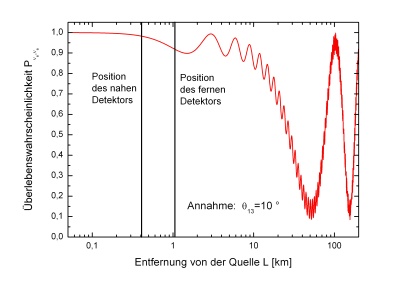
Figure 2: Survival probability (= 1 minus conversion probability) of electron antineutrinos assuming that the value of the sought-after mixing angle is 10 degrees.
The radioactive decay of fission products in a nuclear reactor produces electron antineutrinos as a by-product,
escaping in all directions. One of two detectors is placed relatively close (at 0.4 km) to the reactor. On their
way to this near detector, the anti-neutrinos have not yet the possibility to convert into another flavour. In
contrast, the second detector is placed at a larger distance (at 1.05 km), where conversions become more probable.
The detectors are able to measure exclusively the rate and the energy spectra of the electron antineutrinos
produced in the reactor. If less neutrinos than expected due to the distance-induced dilution are observed by
the far detector, it can be assumed that a part of the electron antineutrinos have converted into another flavour.
The oscillation amplitude sin2(2θ13) can then be derived from the event rate and
energy spectrum of the far detector relative to the near detector after correcting for 1/d2
(d: distance source – detector). In this way, uncertainties related to the reactor neutrino flux and energy
spectra, as well as for detection efficiencies are minimized.
Principle of the Detector
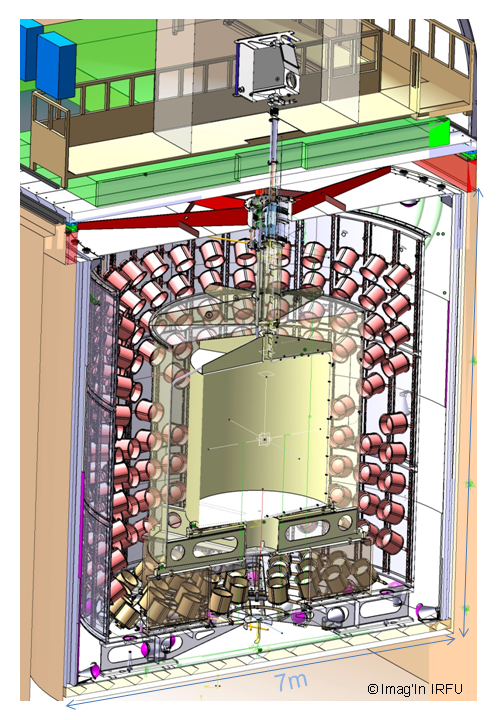
Figure 3: Schematics of the design of the Double-Chooz detectors.
The detector consists of several parts, which fulfill special requirements. In the innermost of the detector,
the neutrino reactions will be detected using a liquid scintillator. A neutrino hits a proton
generating a neutron and a positron (the antiparticle of the electron).
Both reaction products are recorded in order to obtain a clearly defined neutrino signal: The positron
annihilates together with an electron from the surroundings thereby producing two highly energetic photons.
To capture the neutron, the scintillator contains gadolinium (Gd). Highly energetic photons are also emitted in
this capture process, but somewhat delayed with respect to the positron signal. In the liquid scintillator
contained in the two inner compartments of the detector, the energy of the photons is successively converted
to finally obtain visible light. This light is detected by photomultiplier tubes. Photomultipliers are
devices which can convert single photons in the visible region into an electrical signal.
The outer part of the detector serves as a shielding against radioactive radiation from the environment.
The fourth compartment is used to suppress the background. Particularly cosmic muons, which could interfere
with the measurement, are recorded in this part of the detector.
Results
The Double Chooz far detector was filled by the end of 2010 and first results with one detector only were published
in November 2011. For the first time a reactor neutrino experiment presented an indication of electron
antineutrino disappearance at short baselines consistent with neutrino oscillations and a non-vanishing value for
the neutrino mixing angle θ13. With the start of the second detector in early 2015 a sizeable improvement
in terms of systematics and statistics could be achieved. The updated analysis can exclude a zero value for
sin2(2θ13) and the no-oscillation hypothesis with
Double Chooz data at a probability of more than 5 standard deviations. In the analysis the neutrino rate as well as
the shape information of the measured neutrino energy spectrum are included.
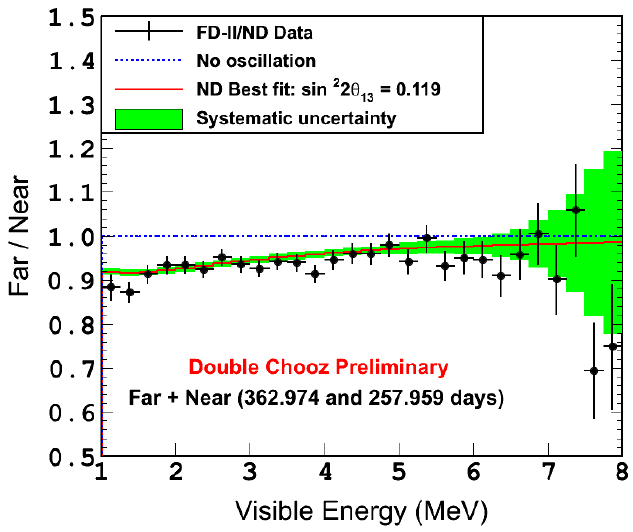
Figure 4: Ratio of measured prompt energy spectrum (data points) between far and near detector. The blue dashed line
shows the no-oscillation scenario while the red line indicates the best-fit model when allowing for neutrino oscillations.
Several analysis cross-checks were done. The mixing parameter was also determined using a
sample of neutrino interactions in which the neutron produced in the inverse beta-decay is captured on H atoms
and Gd atoms in the scintillator. Although the background rate is higher in this analysis it has
the advantage of adding a factor two higher statistics. The result that was found is consistent with the
one of the Gd-sample. The best fit value of
sin2(2θ13) = 0.119+-0.016 is by 2.2 standard deviations higher than the results of other reactor
antineutrino experiments in China (Daya Bay) and Korea (RENO).
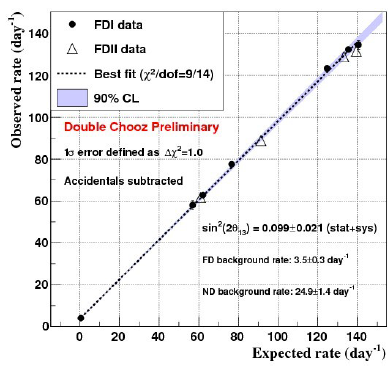
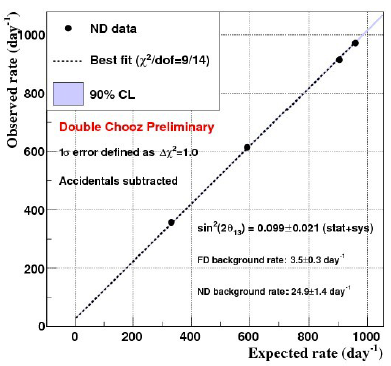
Figure 5: Combined fit result of the reactor rate modulation analysis.
Moreover, an independent analysis based on rate-only information was performed. Here the observed and expected
(in absence of oscillation) neutrino candidate rates are compared for different reactor power conditions, e.g.
with both reactors on, one reactor off, both reactors off or intermediate configurations when the reactors are
not running at full power. Plotting the observed candidate rate versus the expected rate for these different
reactor power conditions allows to fit the data points with a linear model parametrized by θ13
and the background rate. The advantage of this approach is that no a priori assumptions on the background need
to be made, since the analysis is independent of background models. A combined fit for H and Gd data samples was
performed giving a result of sin2(2θ13) = 0.099+-0.021 which is in very good agreement
with our rate and shape result. This proves the robustness of these antineutrino analyses in Double Chooz.
The DC systematic error is dominated by the number of protons inside the scintillator.
A dedicated campaign for improved proton number estimation is foreseen during DC decommissioning in 2018.
Double Chooz and the MPIK
The MPIK is one of the initiators of the experiment. Feasibility studies were performed, a novel
gadolinium-loaded liquid scintillator was developed and produced, and the unloaded scintillator was optimized.
Further, a large part of the photomultipliers was tested and characterized at the MPIK and prepared for their
integration into the experiment. The institute is also strongly involved in Monte Carlo simulation studies and
in the data analysis.
The liquid scintillators consist of organic compounds. The main difficulty in the production of a
gadolinium-containing scintillator is to find a gadolinium compound, which is soluble in an organic liquid.
This can be achieved by a complex compound with special beta-diketones. Their synthesis and purification
procedures were developed at the MPIK. In addition, a number of requirements must be fulfilled by the
scintillator: stability for several years, compatibility with the surrounding materials, radiochemical purity,
and suitable optical properties. The scintillator must produce as much as possible visible light per event.
At the same time, it must be as transparent as possible for this light in order that most of the light arrives
at the photomultipliers. These and further optical properties were analyzed and optimized by adjusting the
chemical composition of the scintillator accordingly.
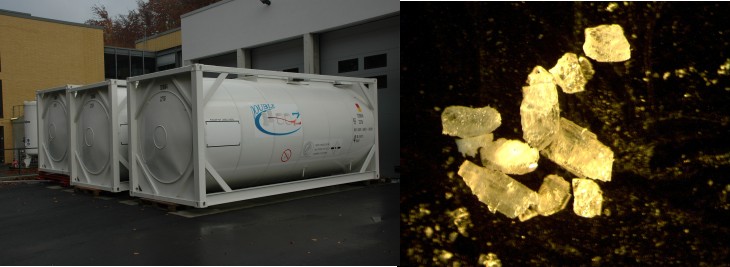
Figure 6: Tanks for the liquid scintillator and crystals of the gadolinium complex.
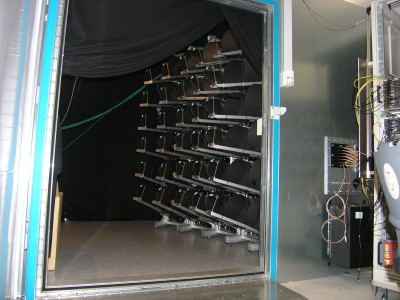
Figure 7: Test rig for 30 photomultipliers in the light-protected Faraday cage.
The light emitted by the scintillator is recorded by 400 photomultipliers in each detector. An accurate
calibration of the photomultipliers is a prerequisite for an exact reconstruction of the energy of a
neutrino event. For this purpose, at the MPIK in close cooperation with Japanese scientists, every single
of the 800 photomultipliers was characterized with respect to its features like, for example, quantum
efficiency, quality of the signal and time resolution. For an efficient testing of this high number of
photomultipliers, a test rig in a Faraday cage was set up. In this lightprotected chamber, 30 photomultipliers
were arranged in a matrix and thus be tested simultaneously in a comparative manner. Several pulsed
light sources like lasers and LEDs, and a data acquisition system were installed inside the chamber.
On the simulation side the focus was on the optical modelling of the scintillation light production
and propagation in our detector. The Geant4 based detector simulation includes scintillator parameters
which are specific for our liquids and were obtained by dedicated measurements in our laboratories. The
main input parameters are light yields, attenuation lengths, emission spectra, quenching factors, reemission
probabilities, refractive indices and quenching parameters. In a final stage these parameters need to be
tuned in the simulation to match detector data, in particular the data taken with calibration sources
(neutron and gamma sources at various energies are used).
Concerning the analysis of detector data the key aspects of our activities are related with the understanding
of the energy scale and detector efficiency studies. In particular, we analyze the position dependence of the
detector response, energy non-linearity effects and the stability of the energy scale. Furthermore, edge effects
related to the Gd-capture efficiency close to the acrylic vessels and efficiency studies in general using
calibration data from neutron sources are investigated. Finally, we combine the results of the Double Chooz
experiment with those of other experients in a global analysis.
Further information can be found on the
official Double Chooz web page.
References
[1] Double Chooz Collaboration, Phys.Rev.Lett.108, 131801 (2012).
[2] Double Chooz Collaboration, Phys.Rev.D 86, 052008 (2012).
[3] Double Chooz Collaboration, Phys.Rev.D 86, 112009 (2012).
[4] Double Chooz Collaboration, Phys.Rev.D 87, 011102(R) (2013).
[5] Double Chooz Collaboration, Phys.Lett.B 723, 66-70 (2013).
[6] Double Chooz Collaboration, Phys.Lett. B735, 51-56 (2014).
[7] Double Chooz Collaboration, Nucl.Instrum.Meth. A764, 330-339 (2014).
[8] Double Chooz Collaboration, JHEP 1410, 086 (2014); JHEP 1502, 074 (2015)
[9] Double Chooz Collaboration, JHEP 1410, 32 (2014).
[10] Double Chooz Collaboration, JHEP 1601, 163 (2016).
[11] Double Chooz Collaboration, Phys.Rev. C93, 054608 (2016).
[12] Double Chooz Collaboration, JINST 11, P08001 (2016).
[13] C.Bauer et al., JINST 6, P06008 (2011).
[14] C.Aberle et al., JINST 6, P11006 (2011).
[15] C.Aberle et al., Chem.Phys.Lett. 516, 257-262 (2011).
[16] C.Aberle et al., JINST 7, P06008 (2012).
[17] F.Kaether and C.Langbrandtner, JINST 7, P09002 (2012).
[18] J.Haser et al., JINST 8, P04029 (2013).
Contact:
- Prof. Dr. Manfred Lindner :
Tel: +49 (0) 6221 516800
E-Mail: manfred.lindner [at] mpi-hd.mpg.de
-
Dr. Christian Buck
Tel: +49 (0) 06221 516664
E-Mail: christian.buck [at] mpi-hd.mpg.de